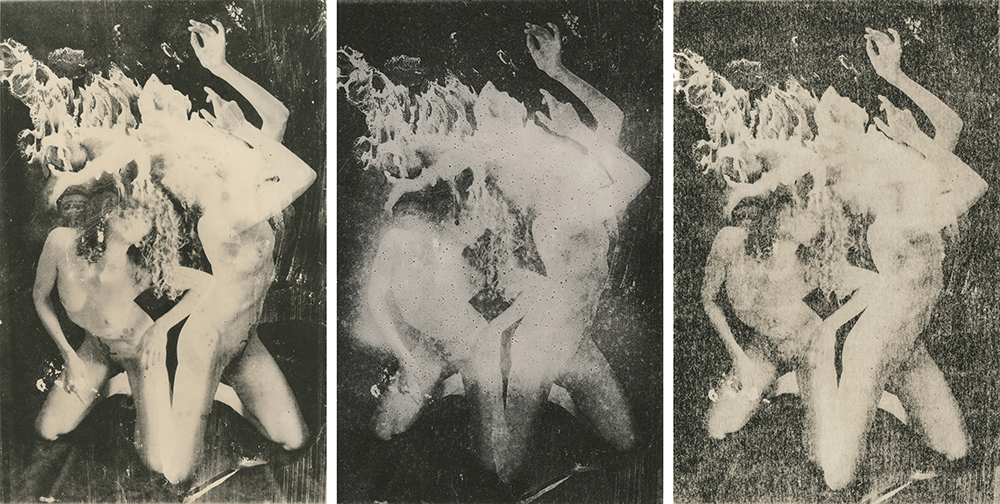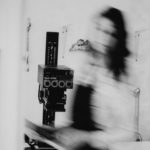Translated interview with Les Nouveaux Riches in March 2021
The self portraits of Kristina Feldhammer merge photography, darkroom techniques and performance. They are improvised and staged at the same time. Born 1991 in Salzburg, she taught herself how to operate analog cameras, develop film and print her own images over the years. The work of the now Vienna-based artist thematises the relationship of the human body and its environment. It also focuses on topics such as mental health and how the own body can be a voice for the Suppressed, the Hidden and the Forgotten within.
How did you get into photography?
I bought my first analog camera when I was 14. Somehow it was the most natural way for me to be creative, but over the years has become more of a means to an end. I also wouldn’t call myself a photographer. Yes, I work with a camera, but what is much more important to me is the improvisation, the intuitive, physical expression in front of the camera. Also the darkroom work is really essential for me, and means quite a bit more than the photographic process does.
I just never really dared to fully delve into performative art and dance, and so at some point I started to simply perform for myself, which I then document through my images. Even though, “documenting” never was enough for me. I want to create pictures that consist of multiple layers. So there is the performative one, but there’s also the purely visual, “staged” layer that kind of alienates, defamiliarizes and it has the potential to change the bodily expression of the performance into something entirely different again.
Sometimes it seems absurd to me, that I try and (literally) capture movement and something so complex as the human body in all its being and expression. But then again, it’s exactly this contradiction that makes it interesting for me again.
What fascinates you the most about it?
In regards to the body in general: everything about it is fascinating to me (again and again)! How the body works; how everything is interconnected in it; what can be released through it/through its movement; the many ways it allows us to interact with our surroundings; how we move it and how it mirrors what moves us; body language, body memory, body images… there is so much that’s really worth digging into.
When it comes to working in the darkroom: on one hand it offers me a possibility to wind down, to just observe but be active at the same time. It’s really interesting how quickly control and coincidence can blend into each other in there. I appreciate the intuitive and mainly work with alternative and experimental printing techniques which require a lot of trial and error, no matter how often you have already done something. Sometimes this can be frustrating, but most of the time it’s exactly what I love about this process – the complete devotion to chance.
What is the message behind your images?
This really differs from work to work and also has the freedom to change.
Sometimes I photograph a series and won’t touch the negatives for a couple of months. So when I get back to work on them, my approach to, or my view of what is pictured on them might have already changed.
When I return to old images after years and look at them again, the message that I would ascribe to them now is often very different to what it was when they were made.
Generally speaking, I’m interested in the moments where there is a breaking, or a dissolution of the borders between the self and the other – “the other” including just anything and everything that isn’t considered part of oneself.
It’s about points of contact, merging points. Between body and everything that isn’t body; between self-discovery and self-loss; between emergence and decay; between personal and collective; between improvisation and staging.
I like the idea of the body as a mirror of all worlds (outer as much as inner) – the body not as an object functioning in society, but as a pulsating, interconnected yet distinct, ever changing life.
Naked skin. Do you have a favorite body part?
No, but skin itself is pretty cool – all the little patterns on our hands, fingerprints, stretch marks, the colors of a bruise…
The skin divides our inner organs from the outside but at the same time it’s also what connects us to the environment, the air etc. It’s an interface.
Skin has so much immediacy about it, which I find incredibly interesting.
Where do you get inspiration for projects?
The term inspiration is always a bit difficult for me… I mean, pretty much everything can be inspiring if one can really engage with, or immerse oneself in a certain thing/ topic. And very often it seems mandatory that (good) art can only be created when there is enough inspiration.
I’d say it can be so important to just sit down (or, move around) and make something – no matter whether one feels inspired or not. And I’m not talking about “producing” something for the sake of productivity, but to play around, to open up to whatever is there even if it seems there’s nothing.
Sometimes, it just won’t work out, and that’s okay. Other times the result itself isn’t very satisfying but at least you made yourself feel curious again and got some new ideas for other things. And sometimes it even happens that you completely surprise yourself and things emerge that could never have been planned in that way.
So maybe you could say that improvisation (and whatever happens in that place/ state) is my inspiration.
What else are you interested in?
At the moment: bird watching.
What are you currently working on?
In the beginning of the year I decided to release quarterly zines, which feature a small part of the work I made during that timeframe. I was tired of not being able to show my work physically, so that seemed like a good alternative.
There will also be a “proper” publication in the form of a photo book, featuring selected self portraits from the last few years.
And there is also a public, collective performance piece that I finally want to venture on.


